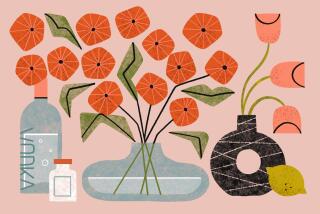Dried & True
- Share via
For gardeners, there’s no better way to preserve their favorite blooms than to make a dried flower arrangement.
“Fresh flowers are beautiful, but they don’t last long and are seasonal. A dried arrangement can brighten up a house at any time of the year,” said Orange interior designer RoxAnn Johnson.
Drying flowers also gives you the opportunity to save flowers that have sentimental value.
“It’s possible to preserve keepsakes such as bouquets and corsages,” Johnson said. “I recently dried a bride’s bouquet, preserved it with floral spray and now it’s displayed under a glass dome in her home.”
Some couples even choose to have dried flowers, instead of fresh, for their wedding. “They impart an antique elegance,” said florist Pat Gosnell, who owns Regal Flowers in Orange. “Silks are excellent nowadays and fresh flowers are always wonderful, but people still like the natural look of dried flowers.”
With a little experimenting, most flowers and many types of foliage can be dried.
Orange wholesale florist and designer Carol Booth has dried hydrangeas for years. “I like to dry hydrangeas, because they’re a whole, complete flower, and if you pick them at the right time, they stay pretty,” she said. For best drying results, hydrangeas should be picked in the summer and fall when the plants are in full blossom.
Other good drying choices include artichoke flowers, baby’s breath, celosia, Chinese lantern, eucalyptus, ferns, globe amaranth (Gomphrena), fescue grasses, larkspur, lavender, leather leaf, love-in-a-mist, magnolia leaves, mimosa (Acacia baileyana), money plant (lunaria annua), moss, oat, poppy pods, protea, Queen Ann’s lace, rose, rye, sage, statice, strawflower, sunflower, wheat and yarrow.
When they dry, flowers generally change in appearance and color, Gosnell said. Foliage shrivels and might fade, and flowers also shrink and change color. Deep-red flowers become a dark grape, almost black; dark pinks become lavender; light yellows fade out to cream; dark yellows become mustard; oranges often turn a deep cherry red; soft corals turn pink; and white becomes ivory or brown.
*
Keep the following tips in mind when drying and displaying flowers.
* Choose vibrantly colored flowers for drying, because light colors tend to fade.
* Most flowers are best picked for drying in the morning when they are open. Pick roses when they are just starting to open.
* Air drying is the easiest, least expensive method of drying flowers.
To air dry, hang flowers upside down in a warm, dry place with good air circulation. Dry in small bunches or single flowers, as they cannot be separated once dry, and they dry more thoroughly when there aren’t too many. To preserve color, do not hang in direct sunlight.
* Dry top-heavy or difficult-to-hang plants such as sunflowers, artichokes and hydrangeas right-side up. Place a piece of chicken wire over the top of a box deep enough to contain the stem. Push stems through the chicken wire so flower heads rest on top of the mesh right-side up.
* Flowers are dry when they become papery and lightweight, and stems and leaves have shrunk. Don’t remove them too soon, or they might mildew.
* To dry in the microwave, place a flower in the microwave with a cup of water. Set for six minutes on high and let the flower cool before touching.
* Spray flowers with an insecticide when you pick them, or check dried flowers periodically for pests, as they do attract moths and bugs. If you have an infestation, remove the infected plants immediately and lightly spray the remaining flowers.
* Store dried flowers in airtight containers until ready to use.
* Handle dried flowers and foliage as little as possible, as they are brittle and fragile.
* If the foliage on your dried flowers is distorted or unattractive, hold the flowers over boiling water for a moment, Gosnell said. The steam will soften the flowers so that you can reshape them.
* If you need longer stems or if a stem is weak, reinforce with wire and cover with floral tape.
* Lengthen the life of the arrangement and preserve the flowers by spraying with a dried-flower sealant. This will protect the flowers against moisture, which leads to fading.
* Avoid placing dried flowers in areas where they will get bumped, because they shatter easily. Also keep them out of direct sunlight, which will fade them. And avoid placing them outdoors, as they will probably be picked apart by birds, which like the natural materials for their nests.
* Dust them. The best way to do this is to blow on them or use a blow-dryer on the lowest setting.
* Use your imagination when using dried flowers. Dried flowers in a basket could serve as an accent piece. Place a green oasis in a basket, insert flowers and cover with filler material such as moss.
One attractive, easy-to-assemble arrangement is a cut flower basket. For this, use a large, oval basket and lay the flowers inside as if you had just cut them.
Dried flowers arranged in a clear glass vase or on wreaths are also attractive.
* Carol Booth of C. Booth Ltd. can be reached at (714) 921-0646.
* Regal Flowers, 658 N. Tustin Ave., Orange. (714) 532-2518.
Make a Wreath
* Fall provides the perfect ingredients for a dried flower wreath. N4






